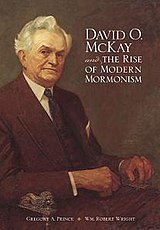 | |
| Author | Gregory Prince and Wm. Robert Wright |
|---|---|
| Language | English |
| Subject | David O. McKay |
| Genre | Biography |
| Published | 2005 (University of Utah Press) |
| Publication place | United States |
| Media type | Print (Hardcover) |
| Pages | 490 |
| ISBN | 0-87480-822-7 |
| OCLC | 57311904 |
| 289.3/092 B 22 | |
| LC Class | BX8695.M27 P75 2005 |
David O. McKay and the Rise of Modern Mormonism is a biography of David O. McKay, the ninth president of The Church of Jesus Christ of Latter-day Saints. It is the first book to draw upon the David O. McKay Papers at the J. Willard Marriott Library, University of Utah, in addition to some two hundred interviews conducted by the authors, Gregory Prince and William Robert Wright. [1] The work was first published on March 9, 2005, through the University of Utah Press and was met with mixed reviews. [2]
Contents
Based largely on an extensive body of records gathered and maintained by McKay's longtime secretary, Clare Middlemiss, the book focuses on the years of McKay's presidency, during which the Church of Jesus Christ of Latter-day Saints faced the challenges of worldwide growth in an age of communism, the American Civil Rights Movement, and ecumenism.